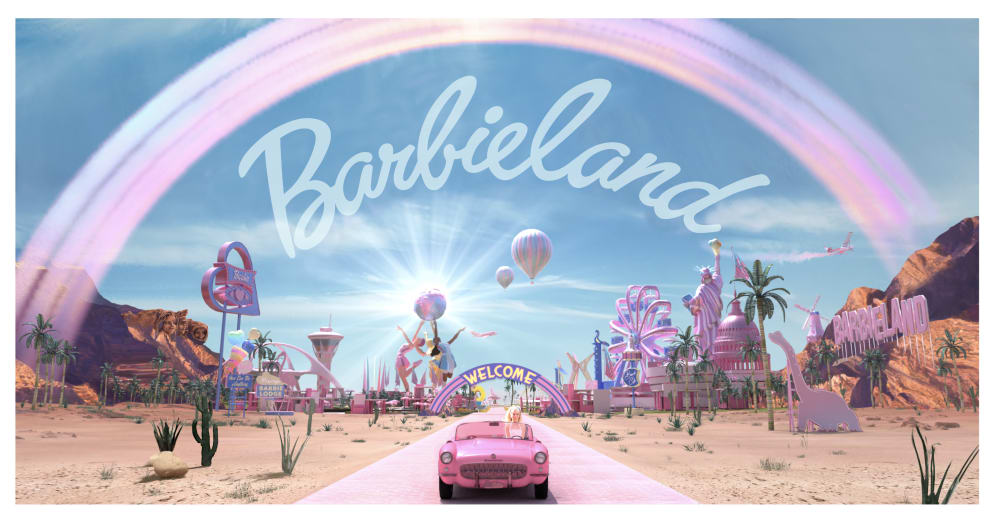
A world of its own! Production designer Sarah Greenwood talks Barbie, Wimbledon and her career
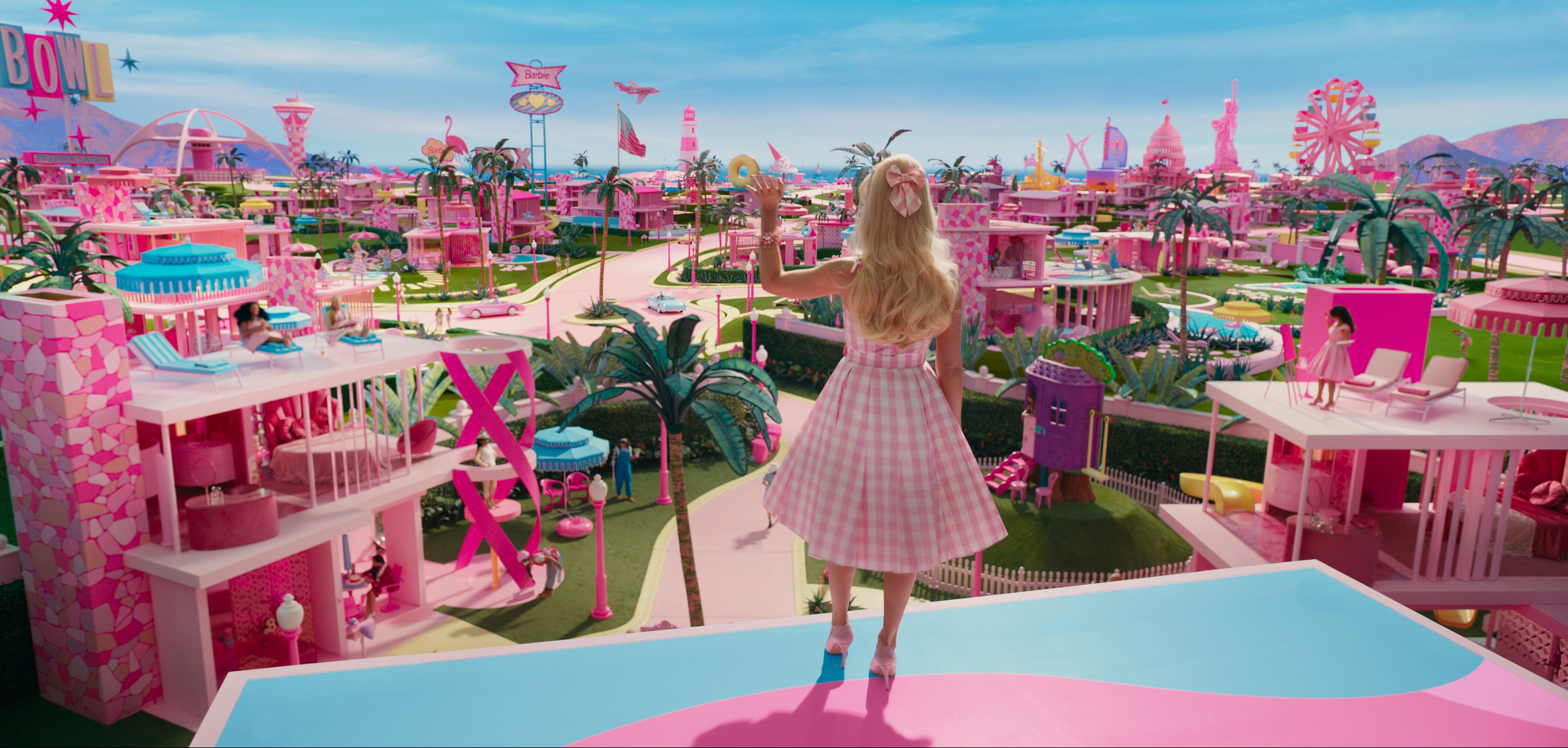
- Written byEuan McLaren
- Published date 21 July 2023

It was December 2020 and production designer Sarah Greenwood was wrapping up filming for Cyrano on top of Europe’s most active volcano when she received a call from writer and director Greta Gerwig, asking her if she would be interested in working on the new Barbie film.
“It was just surreal. We were up on top of Mount Etna filming Cyrano and Greta and I were having these phone conversations while I was standing in 2 feet of snow with the rumbling of the volcano in the background.”
Officially starting work on the film in autumn 2021, Sarah recalls being met with surprise when telling people that she and long-time friend and collaborator, Katie Spencer, would be working on Barbie – “It's apparently not our thing”, Sarah smiled. Sarah’s numerous accolades have primarily recognised her work on period films – including Pride and Prejudice, Anna Karenina, and Atonement – a far cry from Barbie Land. Gerwig, however, recognised Sarah’s innate ability to create whole worlds in her designs and “Barbie is the most complete world of all, right?”, Sarah laughs.
Graduating from Wimbledon College of Arts in 1982, having studied BA Theatre Design, Sarah is a 6-time Academy Award nominee and won the Art Directors Guild Award for Excellence in Period Film in 2013. Now, 41 years later, Sarah reflects on what she describes as “the most complicated and psychologically difficult film I've ever worked on”.

Sarah speaks to Wimbledon College of Arts about her time studying, entry into theatre, film and television and her experience of working on Barbie.
Hi Sarah! Can you tell us a bit about yourself and how you became interested in the world of theatre, film and television?
As long as I remember, the only thing that I've been interested in is art. One day I saw a poster saying ‘theatre design’ and I realised, in that moment, that it had never actually occurred to me that you could study theatre design. I went on to complete a 2-year foundation course before applying to Wimbledon College of Arts as my first choice.
What was your experience of studying at Wimbledon like?
Wimbledon College of Arts was brilliant. It had its own theatre, there were opportunities to try your hand at other art forms and we worked very closely with external organisations like LAMDA and the National Opera Studio. I remember often working with up-and-coming opera singers and people like John Copley (renowned opera director and producer). We weren't bound by restrictions of technicality or budget at Wimbledon; you were forced to think creatively and let your imaginations grow with the projects. We had incredible tutors too. I completed my final year project in 1982 with support from artist and filmmaker Derek Jarman, who was a visiting tutor at the time. We were working on Shakespeare’s The Winter's Tale and Derek taught us for a whole term. It was just sublime working with someone like Derek. He touched so many people, was so influential and such a genuine creative soul. I feel so lucky to have come across him at that point in my life.
You started your career in theatre. What informed the shift from theatre into film and television?
A couple of things. I have a lot of friends who are brilliant at theatre design - Stuart Laing for example – whom I’m very close with. And the thing was, they were brilliant, right? And I just knew that I didn't think quite the way they thought. My work in theatre was good, but I always felt a kind of creative dissatisfaction. I never felt able to transcend.
And then I saw an advert for a holiday relief design assistant at the BBC and I went for it. I had a 3-month contract, and I went backwards and forwards between the BBC and theatre for a couple of years before making the jump. What was interesting is that there was a real snobbery towards film and television at the time. Now, it's very embraced and the 2 disciplines are symbiotic; they feed off each other. But back then, if you even mentioned film or television, it was scorned. Moving from theatre to television, you were seen as selling your soul to the devil.
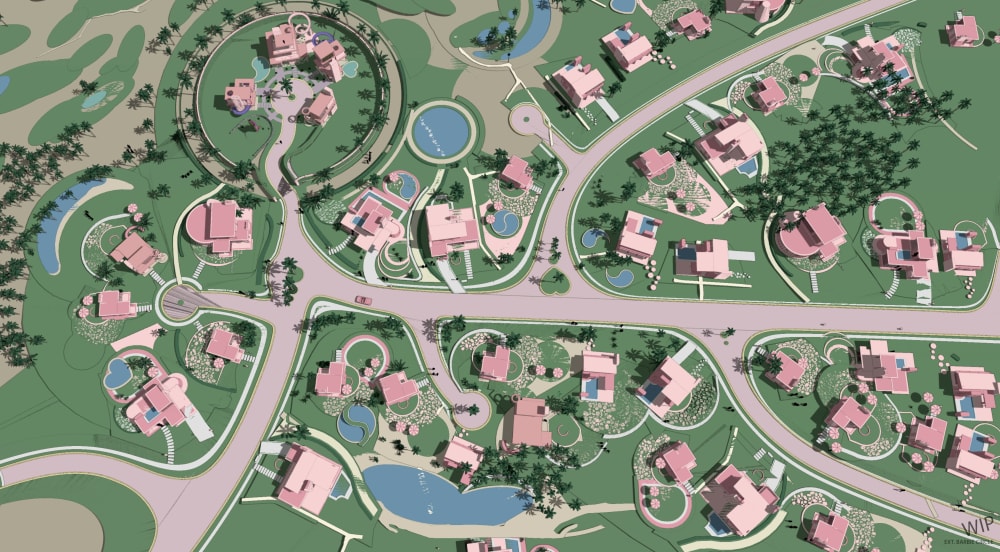
Let’s address the pink elephant in the room: how did you get involved with Barbie in the first place?
It’s funny because when I told people that Katie Spencer and I would be working on Barbie, they were shocked. It's apparently not our thing. But of course, it is! This is a Greta Gerwig script, it was always going to be something else. It was actually the costume designer, Jacqueline Duran, who worked with Greta on Little Women, who got in touch to say, ‘Prepare yourself - I think this script is coming to you.’ And so, I read it and it was the most amazing script. It was like nothing I’ve ever read before. It was a stream of consciousness. It wasn't broken out into scenes, it would talk about the fourth wall and talk to you as the reader, it would mention characters with the actors that she wanted to play the characters and things like that.

When you signed on to do the film, where was the logical starting place for you?
To be honest, there was no logical starting place because, I mean, it’s Barbie! It’s a complete world of its own. For me, the most important thing is the story, the characters and the narrative. My work is an interpretation of the director’s vision. You’re not an expert in what you're doing until you start to really look at it and research. Once you find out what the story is about and how best to tell that story, then you start to understand how you will approach it. You have to find the key - be it through a particular colour, a place or environment, or a sense of light – and this always comes from the script. That’s the most important thing.
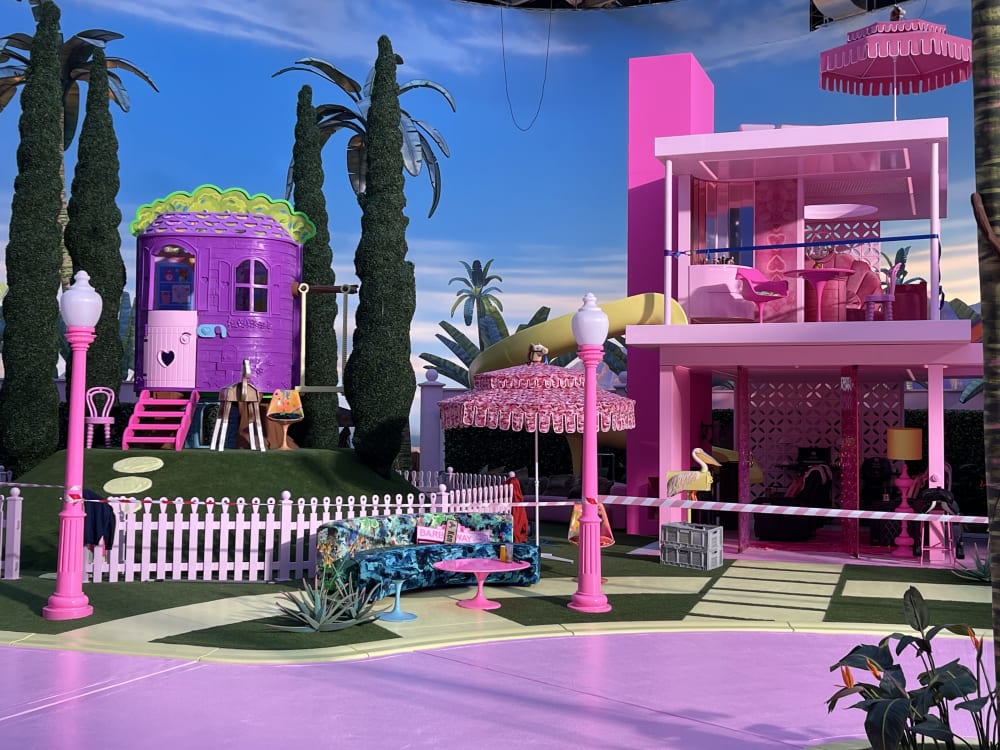
Can you tell us more about your approach to the design for Barbie?
We focused a lot on the toys initially. We wanted to reference Mattel, not reproduce it, so there was a lot of questioning how it would work. It was about getting to understand the toys and the world from their point of view specifically. There's no light in Barbie Land, there's no water in Barbie Land, so it’s interrogating questions like – how do we make the sea?
Early on in the process, we bought some Barbies and a dream house and what was fascinating was that Barbie doesn't fit – be it the car or the house - she's always too big. So, we worked out the scale from playing around with the toys and eventually we decided everything we built for the set would be 23% smaller than human size. We made the depth of the house much smaller - they're probably about 10 feet wide, and, of course, they have no walls. When you look through the dream house, you see the other Barbies and Barbie Land because we are emulating this perfect world where there's no shame. It's like Adam and Eve at the beginning of time.
Apart from scale, another thing we had to solve was colour. I think I almost broke the internet when I said the world ran out of pink, but it was true!

We were looking at all the different pinks and had long conversations with Greta and Rodrigo Prieto – the cinematographer - about what worked and what didn’t - millennial pinks, salmon pinks – all sorts. We looked at what the different pinks did against blues and yellow and green and eventually, we found that everything just started to look really dull and grey, so we ended up using this really pure pigment that was fluorescent pink. We used that as a base pigment and built it up, which gave us this amazing palette. We ended up creating around 11 shades of pink and we used these shades to develop the other colours – the yellows, the blues, the greens that we used for the props and vehicles. The set construction and costumes had a broader spectrum, but it was all based on those colours.
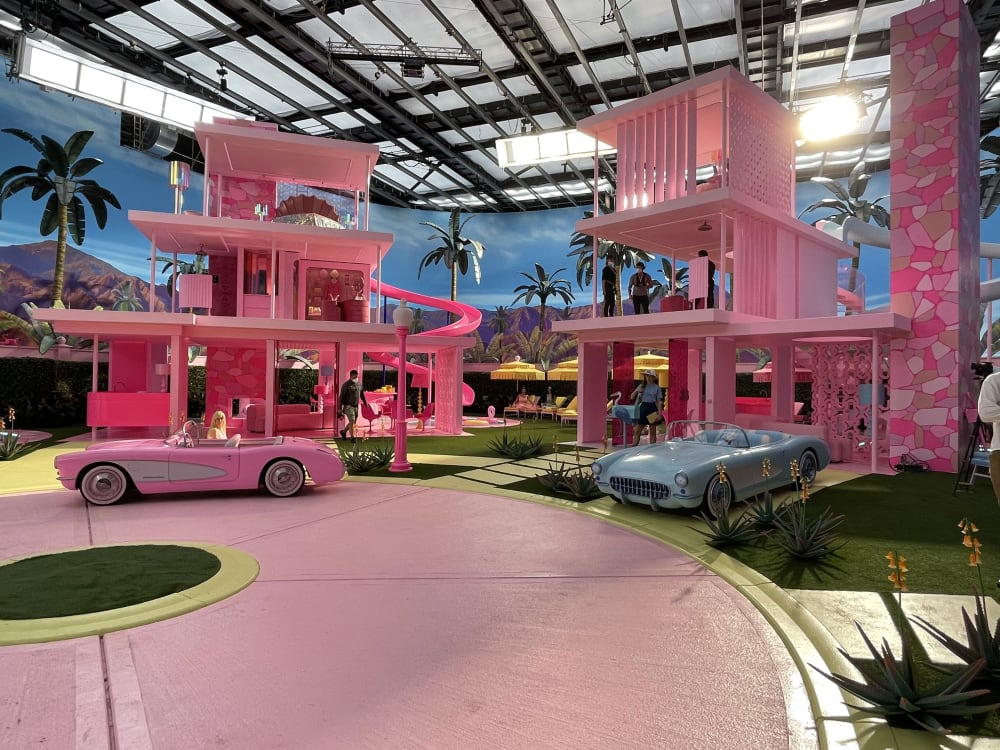
What feeling did you want to try and convey when creating the set?
Greta talked a lot about the ‘philosophical box’ that the houses are in, and I found that really interesting. If you think of the stages we built as the box, then the backgrounds are like dioramas. Looking at the ‘box’, you see 3 dimensional elements, 2 dimensional elements, moments where it goes into false perspective, decals (transfer stickers), real size objects. It’s really about condensing Barbie’s world into this box. There's lots of elements you have to pull together to make it work. We really wanted to have it so when you “opened the box”, it’s better than anything you were expecting. It is the perfect dream house.
Margot Robbie did a piece with Architectural Digest where she gives a tour of the dream house, and it shows that what we're designing is a more rarefied version of the reality.

Aside from the dream house, can you tell us about the design for some of the other scenes in the film?
When we built the beach set, it was going to be massive, but we reduced it down to half the size and then half a size again. So, the beach is a quarter of the size that we originally wanted to build it at. We extended it using CGI. Interestingly, one of the other major things that that Greta wanted to happen was that it was all in camera (physically built sets without greenscreens) as much as possible rather than CGI. The thing with CGI is if you build toys using CGI, then it ends up looking not real. For Barbie, we wanted it to be tangible and real. It looks fake, but it is totally real.
The background cloth is about 50 feet high and around 800 feet long. We advocated for it to be painted, and we had a massive scenic art team. It all goes back to the theatre world, really. There’s a scene in a boat and then a snowmobile where you have different painted parts shot from one angle. Think about the classic rolling waves where the background is static, the next layer moves very slowly, the next layer moves a little bit faster than that, then the layer in the foreground is moving quite fast. You end up with 6 or 7 layers of movement. The mountains are done in 3 layers where they get bigger and further away. Combined with the palm trees, where some are decals, some are 3 dimensional, some are smaller 2 dimensional, you end up with this false perspective. All we're doing is going back to the old-fashioned ways of theatre and film and employing those devices, but with the best technology. You're mixing cutting-edge technology with really old school techniques and I'm afraid that's just me. I just love old school. For me, CGI is too easy an answer and audiences are so savvy nowadays.

What were some of your inspirations and reference points?
One of our key references was looking at the big dance stage films from the 1950s and 60s and how they had an artifice about them. There's a fakeness to it, but there's a glorious fakeness to it and we spent a lot of time working out how to capture this.
It is really interesting having European filmmakers making a film that is so archetypically American because you observe things in a totally different way. If you take the lifeguard station on Malibu beach, European filmmakers look at that and think it’s beautiful, but to LA Americans, it’s just a lifeguard station.
It's set in Malibu, but we were much more influenced by Palm Springs. We looked at thousands of references, but we kept coming back to all these Palm Spring references. The backdrop of the mountains are the San Jacinto Mountains and they're in Palm Springs.
Katie and I went and stayed in Palm Springs for the first time, and it was absolutely fascinating. And I think had we gone to Palm Springs first and done research second, it would have been a mistake because we had that separation; we were slightly outside it.
You mentioned Katie Spencer, whom you’ve worked with a lot before Barbie. What do you enjoy most about collaborating with other TV filmmakers or designers?
Working with other creatives, the ideas just flow. That's the best thing about working with both Joe Wright (director of Anna Karenina, Atonement and Pride and Prejudice) and Katie Spencer: it gives you a freedom to talk about things openly so you're not scared say something that might just be terrible or have a bad idea. You take a joint responsibility, and it creates a certain playfulness. Joe is like my little brother, and we have we have a fair few disagreements but that's great. That's creativity. And there’s other collaborators like Seamus McGarvey and Jacqueline Duran, whom Katie and I have worked with a lot. It's like a big family. Or perhaps more like being in a circus troupe, actually!
And lastly, what advice would you give students who are currently studying at Wimbledon?
It's funny when I first started in the industry, the pathways were so clear, but the industry is so big now, that it's not as simple as it was for me.
I would say don’t be afraid to start small, say yes to all sorts of opportunities, be nice, be charming, be on time. Remember, if you're early, you're on time, if you're on time, you're late, and if you're late, you're sacked, right?
But ultimately, find your people. Find what you love doing and do that.
Barbie is released in cinemas 21 July 2023.
Find out more about BA Theatre Design at Wimbledon College of Arts